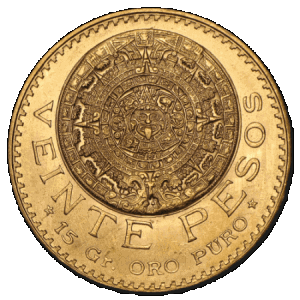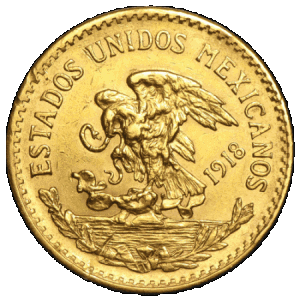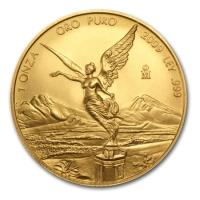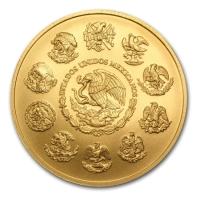Mexican Gold 20 Pesos 'Azteca'

 Mexican 20 Peso gold coins - perhaps the most beautiful gold coins ever minted
Mexican 20 Peso gold coins - perhaps the most beautiful gold coins ever minted
The Mexican 20 Peso gold coins are considered to be the most beautiful gold coins of all time by many precious metal investors and numismatic collectors. Nicknamed 'Aztecas' because of their depiction of the Aztec Calendar Stone (a.k.a. Sun Stone) on their obverse side, the Mexican Gold 20 Pesos are one of the three types of historic Mexican gold coins that are still actively traded today. The other two are the Mexican Centenario gold coins and the Mexican Gold Hidalgos.
The 20 Peso gold coins were minted by the Casa de Moneda de México between 1917 and 1921 and again in 1959. The coins are made of 90% gold and 10% copper and have an actual gold weight of 0.4823 oz. They were never intended to be used as currency. On their reverse side, they show a depiction of Mexico's official coat of arms. It shows a sideward-facing eagle perched on top of a cactus while holding a snake. Mexico's coat of arms is depicted on other gold coins as well but with a forward-facing eagle.
With a total mintage that exceeded 6 million coins, Gold Aztecas aren't rare gold coins. You won't find them as commonly listed for sale online as other gold coins though. If you decide to buy gold in the form of the 20 Peso Mexican Gold Azteca, you should know that the coin was restruck more than a million times in later years, but with the 1959 date! American buyers that are investing in gold for their retirement should take note that the Mexican Azteca gold coins are not eligible for inclusion in Individual Retirement Accounts (IRA's) since they are classified as collectible gold coins by the IRS.


Coin Fact Sheet
| Weight | Face Value | Purity | Diameter |
|---|---|---|---|
| 0.4823 oz | 20 Peso | 90% | 27.5 x 2.03 mm |
Total Mintage: 6,174,000
Design of the Gold Azteca
The Aztec Calendar Stone is depicted on the obverse side of each 20 Peso gold coin. Also known as the Sun Stone, it is believed to have been carved during the reign of the 6th Aztec monarch in 1479. Dedicated to the sun as the principal Aztec deity, it is a large ceremonial object that served as an astronomical/astrological guide. The face value of the Mexican Gold 20 Pesos ("Vente Pesos") is inscribed underneath the stone image along with the gold weight (15 grams).
The official Mexican Coat of Arms is depicted on the reverse side of each coin. It shows an eagle perched upon a cactus while holding a serpent in its powerful beak and talons. The eagle faces sideways, distinguishing the image from the 50 Peso Mexican Centenario where it faces forward. The year of mintage appears to the lower right of the eagle and "Estados Unidos Mexicanos" is engraved on top. The Mexican Gold Azteca coin is the only Mexican gold coin that shows the official version of the country's coat of arms on its reverse side. Mexican coins first used the image of an eagle in 1825.
History of the Gold 20 Pesos
Mexico carried out a monetary reform in 1905 that resulted in the introduction of many new coins in the years that followed. The Mexican Mint (Casa de Moneda de México) issued the Gold 20 Pesos without interruption between 1917 and 1921. In 1959, 20 Pesos gold coins were briefly produced again (13,000 coins) but all coins produced thereafter are restrikes. Since the restrikes of the Mexican 20 Peso gold coins are dated 1959 as well, they are virtually indistinguishable from the official 1959 strikes.
The Aztec Calendar that is featured on the obverse side of this type of Gold Peso coin is closely connected to Mexico's history. When the Spanish conquistador Hernán Cortés conquered Mexico in the year 1521, he is believed to have found the Aztec Calendar at Tenochtitlan's Templo Mayor. The Aztec capital Tenochtitlan was located in the area that is now Mexico City. The Templo Mayor (English: Great Temple) was dedicated to the god of war Huitzilopochtli and the god of rain and agriculture Tlaloc. The Spanish invaders had most of the temple destroyed when they conquered the Aztec capital. The Calendar Stone was buried in the main square of Mexico City and only rediscovered by chance in 1790. It can now be seen in the National Anthropology Museum in Mexico City.
Restrikes of the 20 Peso Mexican gold coin
Modern restrikes numbering 1,158,414 pieces of the 20 Peso gold coin were made between 1960 and 1971 (dated 1959). In addition, 78,000 matte restrikes were produced in 1996 (also dated 1959).
Mintage Numbers
Annual mintage of the 20 Peso Mexican gold coin varied between 13,000 and 2,831,000 coins. The accumulated total mintage number of the 20 Pesos gold coin amounts to about 6.1 million coins.


Mexican Gold Libertads
The Mexican Gold Libertad coins are struck out of 99.9% pure gold since 1981. Their design that depicts the Angel of Independence is inspired by the historic Mexican Centenario gold coins. The Gold Libertads are minted by the Casa de Moneda de México, the oldest mint in North America, in the denominations of 1 oz, 1/2 oz, 1/4 oz, 1/10 oz and 1/20 oz. Both brilliant uncirculated and proof coins are available. The coins don't have an official face value and their annual mintage numbers are much lower than those of other gold bullion coins. Despite that, the coins have legal tender status in Mexico.
The Mexican Gold Libertad page gives more information about the coins and allows you to compare current prices.